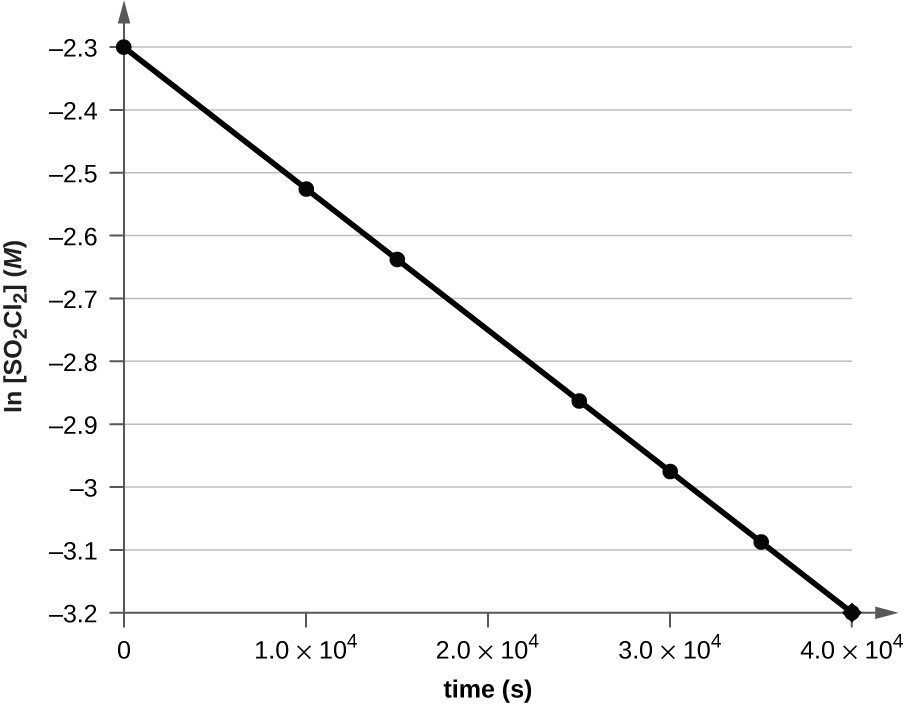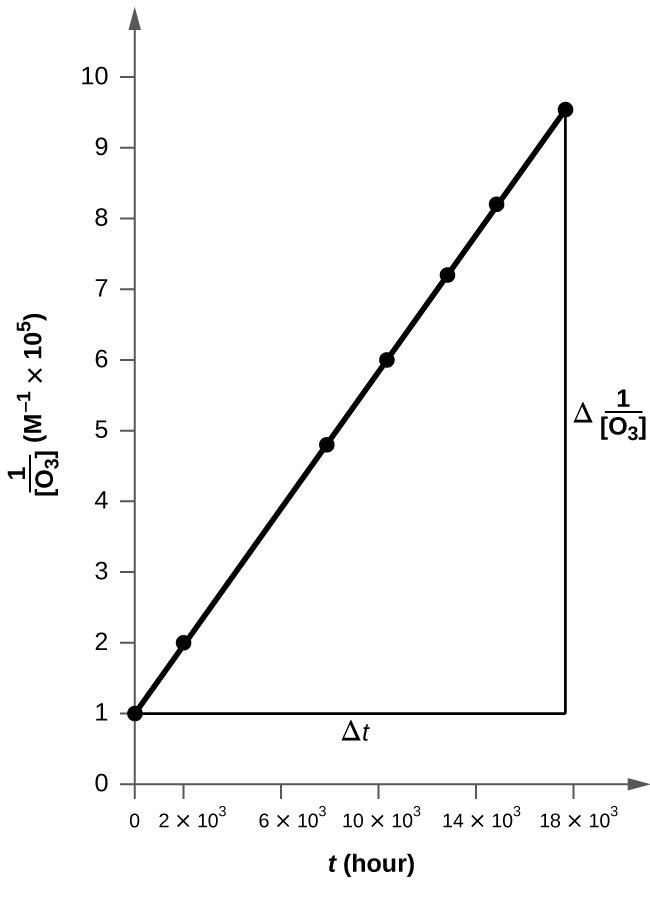Answer Keys to Selected Problems
Chapter 12 Key
12.1. The instantaneous rate is the rate of a reaction at any particular point in time, a period of time that is so short that the concentrations of reactants and products change by a negligible amount. The initial rate is the instantaneous rate of reaction as it starts (as product just begins to form). Average rate is the average of the instantaneous rates over a time period.
12.5. (a) average rate, 0 − 10 s = 0.0375 mol/L·s, average rate, 10 − 20 s = 0.0265 mol/L·s (b) instantaneous rate, 15 s = 0.023 mol/L·s (c) average rate for B formation = 0.0188 mol/L·s, instantaneous rate for B formation = 0.012 mol/L·s
12.7. Higher molarity increases the rate of the reaction. Higher temperature increases the rate of the reaction. Smaller pieces of magnesium metal will react more rapidly than larger pieces because more reactive surface exists.
12.9. (a) Depending on the angle selected, the atom may take a long time to collide with the molecule and, when a collision does occur, it may not result in the breaking of the bond and the forming of the other. (b) Particles of reactant must come into contact with each other before they can react.
12.11. (a) very slow (b) As the temperature is increased, the reaction proceeds at a faster rate. The amount of reactants decreases, and the amount of products increases. After a while, there is a roughly equal amount of BC, AB, and C in the mixture and a slight excess of A.
12.15. (a) The process reduces the rate by a factor of 4. (b) Since CO does not appear in the rate law, the rate is not affected.
12.21. rate = k, k = 2.0 × 10−2 mol/L·h (about 0.9 g/L·h for the average male); the reaction is zero order
12.23. rate = k [NOCl]2, k = 8.0 × 10−8 L/mol·h; second order
12.25. rate = k [NO]2[Cl2], k = 9.1 L2/mol2·h, second order in NO; first order in Cl2
12.27. (a) The rate law is second order in A and is written as rate = k [A]2. (b) k = 7.88 × 10−3 L/mol·s
12.31. rate = k[I−][OCl−], k = 6.1 × 10−2 L/mol·s
12.33. Plotting a graph of ln [SO2Cl2] versus t reveals a linear trend; therefore we know this is a first-order reaction:
k = 2.20 × 10–5 s−1
The plot is nicely linear, so the reaction is second order. k = 50.1 L /mol·h
12.42. The reaction is first order. k = 1.0 × 107 L/mol·min
12.44. 1.16 × 103 s ; 20% remains
|
[A]0 (M) |
k× 103 (s−1) |
|
4.88 |
2.45 |
|
3.52 |
2.51 |
|
2.29 |
2.53 |
|
1.81 |
2.58 |
|
5.33 |
2.36 |
|
4.05 |
2.47 |
|
2.95 |
2.48 |
|
1.72 |
2.43 |
12.50. The reactants either may be moving too slowly to have enough kinetic energy to exceed the activation energy for the reaction, or the orientation of the molecules when they collide may prevent the reaction from occurring.
12.52. The activation energy is the minimum amount of energy necessary to form the activated complex in a reaction. It is usually expressed as the energy necessary to form one mole of activated complex.
12.54. After finding k at several different temperatures, a plot of ln k versus 1/T, gives a straight line with the slope [latex]- \frac {E_a}{R}[/latex] from which Ea may be determined.
12.56. (a) 4 times faster (b) 128 times faster
12.64. Ea = 108 kJ; A = 2.0 × 108 s−1; k = 3.2 × 10−10 s−1 (b) 1.81 × 108 h or 7.6 × 106 day (c) Assuming that the reaction is irreversible simplifies the calculation because we do not have to account for any reactant that, having been converted to product, returns to the original state.
12.66. The A atom has enough energy to react with BC; however, the different angles at which it bounces off of BC without reacting indicate that the orientation of the molecule is an important part of the reaction kinetics and determines whether a reaction will occur.
12.68. No. In general, for the overall reaction, we cannot predict the effect of changing the concentration without knowing the rate law. Yes. If the reaction is an elementary reaction, then doubling the concentration of A doubles the rate.
12.70. rate = k [A][B]2; rate = k [A]3
12.72. (a) rate1 = k [O3] (b) rate2 = k [O3][Cl] (c) rate3 = k [ClO][O] (d) rate2 = k [O3][NO] (e) rate3 = k[NO2][O]
12.74. (a) Doubling [H2] doubles the rate. [H2] must enter the rate law to the first power. Doubling [NO] increases the rate by a factor of 4. [NO] must enter the rate law to the second power. (b) Rate = k [NO]2[H2] (c) k = 5.0 × 103 L2/mol2·min−1 (d) 0.0050 mol/L (e) Step II is the rate-determining step. If step I gives N2O2 in adequate amount, steps 1 and 2 combine to give:
This reaction corresponds to the observed rate law. Combine steps 1 and 2 with step 3, which occurs by supposition in a rapid fashion, to give the appropriate stoichiometry.
12.76. The general mode of action for a catalyst is to provide a mechanism by which the reactants can unite more readily by taking a path with a lower reaction energy. The rates of both the forward and the reverse reactions are increased, leading to a faster achievement of equilibrium.
12.78. (a) Chlorine atoms are a catalyst because they react in the second step but are regenerated in the third step. Thus, they are not used up, which is a characteristic of catalysts. (b) NO is a catalyst for the same reason as in part (a).
12.80. The lowering of the transition state energy indicates the effect of a catalyst. (a) B (b) B
12.82. The energy needed to go from the initial state to the transition state is (a) 10 kJ (b) 10 kJ.
12.84. Both diagrams describe two-step, exothermic reactions, but with different changes in enthalpy, suggesting the diagrams depict two different overall reactions.
(a) O(g) + N2(g) → NO(g) + N(g)
(b) units indicate an overall 2nd order reaction, rate = k [O][N2]
(c) The rate at 2273 K is 1.27 × 1019 1/(M s), which is 4.86 × 105 times faster (or 486,000 x) than the rate at 1273 K.


